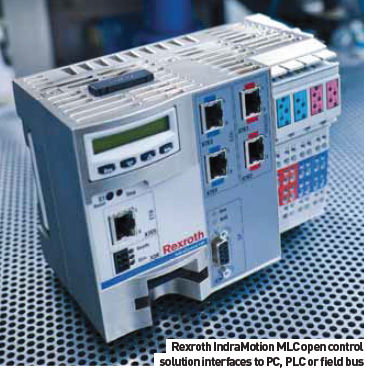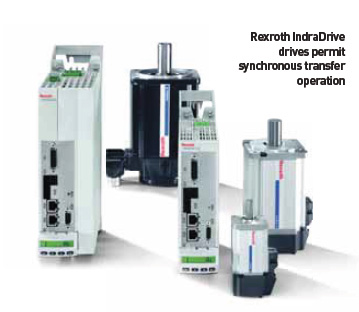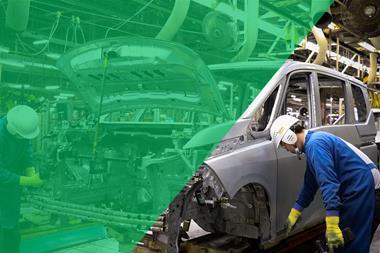The automation of stamping lines, presses and conveyor systems presents a three-fold challenge. According to Siemens, key issues include funding a sizeable investment; maintaining a longterm technology commitment; and utilising customised applications in lieu of off-the-shelf designs. Ensuring efficient production means providing the right foundation for automated systems. After all, the goals are a continuous supply to downstream operations and keeping waste to a minimum. Siemens’ Totally Integrated Automation platform is intended to provide standardisation and modularisation for all press shop operations; enable integration of components from other manufacturers; and deliver effective communications throughout the press shop automation chain.

Communication is particularly important as one key to productivity lies in the smooth interaction of the controllers and drives with the distributed I/O, operator control and monitoring systems. According to Alexandre Bonay, head of business development in metal forming at Siemens Drive Technologies, an optimum solution for a press line would involve the automation, motion, drives and control products all working together in a modular, scalable configuration.
From a Siemens’ perspective these connect with the open networking platform Profinet, to provide end-to-end integration for a transfer press. With a modular, common platform, scalability is achieved using flexible backplane technologies like DRIVE-CLiQ, an open encoder interface that allows users to select a measuring system tailored to the application.
Of course, when automating press line technologies the foremost priority is safety, something of which Siemens is acutely aware. “For entire press lines, Siemens typically uses a dedicated PLC for the press operations and a dedicated PLC for the safety function,” says Bonay. “For a single machine, a customer may use a single PLC with integrated safety module that reduces the need for additional hardware, resulting in cost savings. In addition, Siemens mobile panel HMI products bring integrated safety to a wireless control station that can be used anywhere the operator goes.” Siemens is currently focusing on providing solutions that enable press builders to deliver faster changeover capabilities for their machines. These innovations include the implementation of high speed kinematic models in the company’s motion control products to facilitate optimum material handling solutions. Kinematic models decrease the amount of engineering required to implement such systems. “We also recognise the need for manufacturing solutions that are fully evaluated,” says Bonay. “With this in mind we offer transfer press simulation, tandem line production simulation and die collision simulation.”
The recently introduced Siemens AS-i master CM1243-2 communication module connects AS-Interface networks to the Simatic S7-1200 controller, expanding its application area. The AS-i master enables sensors and actuators to be easily and quickly integrated at the lowest fi eld level both in the Simatic S7-1200 and in the TIA Portal. Confi guration via the TIA Portal is comparably fast and user-friendly, similar to Profi net or Profi bus networks. The AS-i master automatically organises data traffi c on the connected line, handling not only signal scanning but also parameter setting, monitoring and diagnostic functions. It also offers additional integrated functions, such as the confi guration of Sirius M200D AS-i motor starters without additional function blocks, as well as access via a web interface. A total of 62 AS-i slaves or 992 inputs and outputs can be connected.
How changes in die design or transfer design can affect overall part production and lead to a better running production line. Once the simulation has been completed and proven, the software integrates into the Simotion solution for actual production.
Siemens estimates that over 80% of the world’s automotive factories are equipped with its automation products, so it knows a thing or two about industry trends and Bonay has a few words of advice to offer.
“Manufacturing engineers tasked with specifying a new stamping line or overhauling an existing line should consider modular solutions as these can reduce the need for additional hardware and result in cost savings,” he says. “Look for solutions that can link all of the components – including the safety functions – in a single bus system as this will help reduce overall complexity. Also, seek out products that are scalable, modular and based on an open technology architecture that can adapt to changing business needs as this will help protect and maximise the value of the investment.”
Positioned upstream of a press automation perspective, are linear transfer systems and robots. While the capital investment required for the former usually demands high volume, high speed applications, the versatility and relative low cost of robots has seen this technology make recent advances. Typically the volume divide is approximately
With the new version of the IndraMotion MLC, Rexroth is presenting an open motion logic system for easy automation of hydraulic, electric and hybrid drives. It uses fully open standards such as SERCOS III for Ethernet-based, real-time communication and supports both centralised and decentralised architectures. At the same time, a number of hydraulic controllers have already been integrated into the system. The scalable hardware allows for a modular increase in the number of hydraulic drives, by sets of four. The use of the SERCOS III communication system ensures the necessary synchronous communication between controller, drives and I/O, allowing the system to control all drives. For non-real-time critical communication tasks the user can use standard fi eld buses and Ethernet protocols. The Rexroth tool, WinView, which is integrated into IndraMotion MLC, simplifi es error identifi cation and process optimisation by providing diagnostic options. The tool depicts all SPS and process variables in real-time on up to 100 channels and saves these as data logs on the computer. This makes it easier to analyse sporadic system errors and accelerates the re-boot process after a problem has occurred.
250,000 to 300,000 pressed units annually. Up to the former quantity, seven-axis robotic solutions such as the new ABB LinAx and RotAx models can provide a genuinely costeffective solution and rapid return on investment. By maintaining the required orientation during the interpress movement, parts move smoothly with minimum inertia or vibration. According to ABB, robot cycle and press occupation time are reduced significantly, leading to increased productivity.
In the case of new lines, floor occupation can be optimised by the reduction of the inter-press distance, typically up to less than six metres. Different kinematics are used for this purpose: ABB’s RotAx maintains the orientation by combining the sixth and seventh axis rotations, while with LinAx, a linear double action unit enables a linear part movement driven by a servo motor attached to the wrist. This solution is said to combine the relative low cost and reliability of robots with the benefits associated with transferring the part linearly.
ABB has installed more than 500 press lines since the 1970s, has a global team of around 200 people dedicated to the field of press automation, and is rightly excited about its 7-axis robot technology. The ABB seventh axis is an additional external axis integrated to the robot wrist that transports the part from press to press, maintaining the part orientation and thus following the optimal, natural path. The robot wrists, including the seventh axis motors and gearboxes, are maintained out of the dies at all times when transferring parts. Adding a seventh axis to a robot also brings advantages to the tooling. A central boom is no longer required, so only end-of-tool is replaced when preparing new production. For press shops wanting to change product as fast as possible, ABB says the seventh axis performs equally or better than conventional tooling systems with central booms (tool changing is facilitated automatically by the robot within the working area).
So what of press transfer systems? This is more complex technology that can be used either for gripper rail transfer or  vacuum transfer. Typically, the main requirements of such systems include: precision electronic synchronisation of transfer to the press for all press stroke lengths; integrated safety functions such as redundant motor and press transmitters; and an anti-collision strategy in the event of a power cut (with programmable fault response). Rexroth, part of the Bosch group of companies, says its open control solution – IndraMotion MLC – offers standardised interfaces to any PLC, any PC or field bus as required. Here, intelligent servo drives are deployed for gripping, lifting and transporting parts between the various press stages. IndraDrive drives permit intermediate circuit coupling to the main drive as well as synchronous operation of the transfer, even in the event of a power cut, while linear guides feature integrated position measuring systems for workpiece transport.
vacuum transfer. Typically, the main requirements of such systems include: precision electronic synchronisation of transfer to the press for all press stroke lengths; integrated safety functions such as redundant motor and press transmitters; and an anti-collision strategy in the event of a power cut (with programmable fault response). Rexroth, part of the Bosch group of companies, says its open control solution – IndraMotion MLC – offers standardised interfaces to any PLC, any PC or field bus as required. Here, intelligent servo drives are deployed for gripping, lifting and transporting parts between the various press stages. IndraDrive drives permit intermediate circuit coupling to the main drive as well as synchronous operation of the transfer, even in the event of a power cut, while linear guides feature integrated position measuring systems for workpiece transport.
When using either linear transfer systems or robots, the automatic feeding of raw sheets, sheet metal parts, blanks and other flat workpieces into presses makes it necessary to ensure they are fully separated and fed individually to prevent any potential for machine or workpiece damage. With this in mind, the recently introduced double-blank detection (DBD) unit from vacuum technology specialist Schmalz is said to provide a reliable solution. The DBD is equipped with a replaceable bell-shaped suction ring made of the wear-resistant and oil-resistant material NBR, while the sensor ring is equipped with a sensor holder in which any commercially available M42 (or M36) double sheet sensor can be installed.
Schmalz says that its DBD double blank detection unit is available with different tooling connections, including quick-change coupling, facilitating quick, hassle-free installation on loading robots, press feeders or de-stackers. The sensor bracket for the DBD unit is claimed to be both fl exible and spring-mounted: this provides precise positioning of the sensor and reduces erroneous signals. In addition, it compensates for differences in height, including uneven areas and different sheet surfaces while preventing springs from breaking. By separating the vacuum and sensor circuits, it is possible to prevent leakage in the sensor screw connection.
Maintaining the vacuum technology theme, also new on the market, this time from Piab, is the XLF line of extra large flat suction cups which has been designed to handle sheet safely and securely in press shop environments. Available in four different diameter sizes (150, 200, 250 and 300mm), all are designed with an aluminium plate moulded into 60° Shore Nitrile-PVC rubber. This material is PWIS/siliconefree so it doesn’t leave behind any marks on the handled product, eliminating the requirement for extra cleaning. As certain sheets sometimes have sharp edges or corners that can mar or cut a suction cup, leaving a possibility of diminished lifting capacity and a chance of products dropping, the XLF double lip design (inner and outer) increases safety in case of tear or overload. It is possible to use the cups in a customised mounting frame or lifting device handling weights up to 500kg as well as up to 400kg of shear force during vertical handling.
The stamping shop is the engine room of the auto plant and is expected to function around the clock without fault. Automation helps this happen, making press operations safer, faster, repeatable, continuous, free of fatigue and cheaper. Auto OEMs wouldn’t want it any other way.



































